复习:
事件绑定的三种方式:



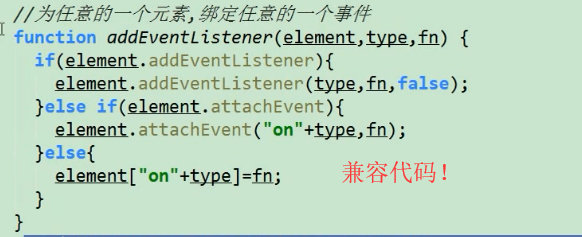
事件:
绑定事件的区别:

为元素解绑事件:
第一种解绑的方式:

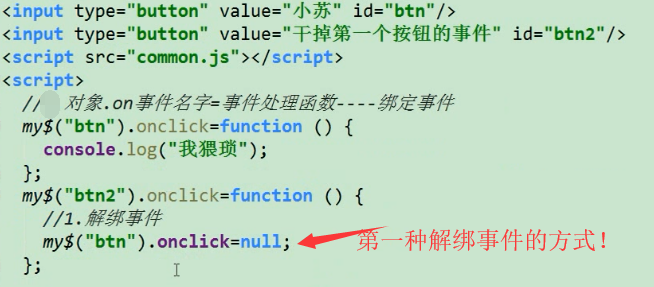
第二种解绑的方式:


第三种解绑的方式:

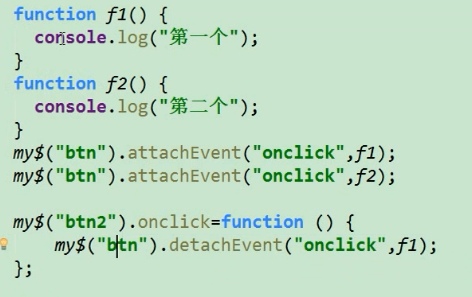

绑定事件和 解绑事件的兼容代码:
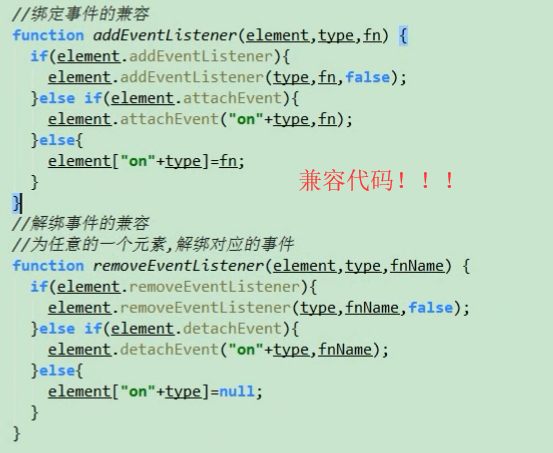

1 //绑定事件 和 取消绑定的 兼容代码: 2 function addEventListener(ele, type, fn) { 3 if(ele.addEventListener){ 4 ele.addEventListener(type,fn,false); 5 }else if(ele.attachEvent){ 6 ele.attachEvent("on"+type,fn); 7 }else{ 8 ele["on"+type] = fn; 9 } 10 } 11 12 function removeEventListener(ele, type, fn) { 13 if(ele.removeEventListener){ 14 ele.removeEventListener(type,fn,false); 15 }else if(ele.detachEvent){ 16 ele.detachEvent("on"+type,fn); 17 }else{ 18 ele["on"+type] =null; 19 } 20 }
到目前为止,common.js 的代码如下:

1 /** 2 * 根据id 或者根据tagName 返回相应的元素 3 * */ 4 function getId$(id){ 5 return document.getElementById(id); 6 } 7 function getTags$(tagName) { 8 return document.getElementsByTagName(tagName) 9 } 10 11 //绑定事件 和 取消绑定的 兼容代码: 12 function addEventListener(ele, type, fn) { 13 if(ele.addEventListener){ 14 ele.addEventListener(type,fn,false); 15 }else if(ele.attachEvent){ 16 ele.attachEvent("on"+type,fn); 17 }else{ 18 ele["on"+type] = fn; 19 } 20 } 21 22 function removeEventListener(ele, type, fn) { 23 if(ele.removeEventListener){ 24 ele.removeEventListener(type,fn,false); 25 }else if(ele.detachEvent){ 26 ele.detachEvent("on"+type,fn); 27 }else{ 28 ele["on"+type] =null; 29 } 30 }
事件冒泡:


1 <!DOCTYPE> 2 <html lang="en"> 3 <head> 4 <meta charset="UTF-8"> 5 <title>这是网页标题</title> 6 <style> 7 #dv1{ 8 width: 300px; 9 height: 300px; 10 background-color: cyan; 11 } 12 #dv2{ 13 width: 200px; 14 height: 200px; 15 background-color: red; 16 } 17 #dv3{ 18 width: 100px; 19 height: 100px; 20 background-color: green; 21 } 22 </style> 23 </head> 24 <body> 25 <div id="dv1"> 26 <div id="dv2"> 27 <div id="dv3"></div> 28 </div> 29 </div> 30 <script src="js/common.js"></script> 31 <script> 32 getId$("dv1").onclick = function () { 33 console.log(this.id); 34 }; 35 getId$("dv2").onclick = function () { 36 console.log(this.id); 37 }; 38 getId$("dv3").onclick = function () { 39 console.log(this.id); 40 }; 41 </script> 42 </body> 43 </html>
事件冒泡有很大的坏处,一般,我们都是组织事件冒泡的。
阻止事件冒泡:

事件的阶段:
1,事件捕获阶段(1代表) :从外到里。
2,事件目标阶段(2代表)
3,事件冒泡阶段 (3代表):从里到外 。

1 <!DOCTYPE> 2 <html lang="en"> 3 <head> 4 <meta charset="UTF-8"> 5 <title>这是网页标题</title> 6 <style> 7 #dv1{ 8 width: 300px; 9 height: 300px; 10 background-color: cyan; 11 } 12 #dv2{ 13 width: 200px; 14 height: 200px; 15 background-color: red; 16 } 17 #dv3{ 18 width: 100px; 19 height: 100px; 20 background-color: green; 21 } 22 </style> 23 </head> 24 <body> 25 <div id="dv1"> 26 <div id="dv2"> 27 <div id="dv3"></div> 28 </div> 29 </div> 30 <script src="js/common.js"></script> 31 <script> 32 var objs = [getId$("dv1"),getId$("dv2"),getId$("dv3")]; 33 // objs.forEach(function (ele,idx,arr) { 34 // console.log("1 "+ele); 35 // console.log("2 "+idx); 36 // console.log("3 "+arr); 37 // }) 38 objs.forEach(function (ele) { 39 //为每个元素注册事件 40 ele.addEventListener("click",function () { 41 console.log(this.id); 42 },false); //如果false 改为ture 就是事件的捕获阶段。 43 }) 44 </script> 45 </body> 46 </html>
查看具体事件的阶段可以通过属性来查看,它在事件处理函数中的参数中 evt.eventPhase .

1 <!DOCTYPE> 2 <html lang="en"> 3 <head> 4 <meta charset="UTF-8"> 5 <title>这是网页标题</title> 6 <style> 7 #dv1{ 8 width: 300px; 9 height: 300px; 10 background-color: cyan; 11 } 12 #dv2{ 13 width: 200px; 14 height: 200px; 15 background-color: red; 16 } 17 #dv3{ 18 width: 100px; 19 height: 100px; 20 background-color: green; 21 } 22 </style> 23 </head> 24 <body> 25 <div id="dv1"> 26 <div id="dv2"> 27 <div id="dv3"></div> 28 </div> 29 </div> 30 <script src="js/common.js"></script> 31 <script> 32 var objs = [getId$("dv1"),getId$("dv2"),getId$("dv3")]; 33 // objs.forEach(function (ele,idx,arr) { 34 // console.log("1 "+ele); 35 // console.log("2 "+idx); 36 // console.log("3 "+arr); 37 // }) 38 objs.forEach(function (ele) { 39 //为每个元素注册事件 40 ele.addEventListener("click",function (evt) { 41 console.log(this.id); 42 console.log("当前的事件阶段是 "+evt.eventPhase); 43 },false); //如果false 改为ture 就是事件的捕获阶段。 44 }) 45 </script> 46 </body> 47 </html>
注意: 事件的捕获阶段是不可能和冒泡阶段同时出现的。
要么是目标 -> 冒泡
要么是捕获 -> 目标

第三个参数如果是false 则是冒泡,如果是true 则是捕获阶段。
事件的总结:

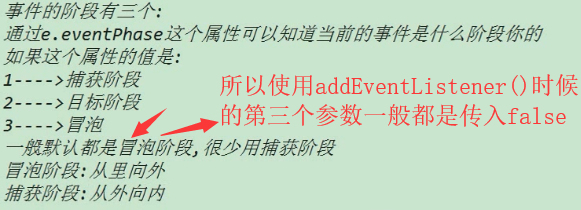
为同一个元素注册多个不同的事件 并用同一个事件处理函数:

1 <!DOCTYPE> 2 <html lang="en"> 3 <head> 4 <meta charset="UTF-8"> 5 <title>这是网页标题</title> 6 7 </head> 8 <body> 9 <input type="button" value="按钮" id="btn"> 10 11 <script src="js/common.js"></script> 12 <script> 13 //为同一个元素绑定 多个不同的事件 ,并用同一个事件处理函数处理 14 getId$("btn").onclick = f1; 15 getId$("btn").onmouseenter = f1; 16 getId$("btn").onmouseleave = f1; 17 function f1(evt) { 18 switch (evt.type) { 19 case "click": alert("鼠标点击了"); break; 20 case "mouseenter": this.style.backgroundColor="cyan"; break; 21 case "mouseleave": this.style.backgroundColor =""; break; 22 } 23 } 24 </script> 25 </body> 26 </html>
